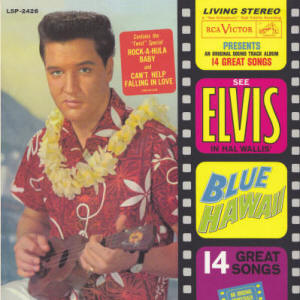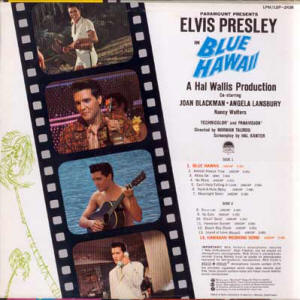

"Blue Hawaii" was released in October 1961
and was the soundtrack of a
movie
with the same name. On the "Top LPs Chart"
the album had a run of 79 weeks, 20 of them at
the number one! As early as December 1961 Elvis
received a Gold Award for the domestic sales of
"Blue Hawaii", in 1992 the status was updated to
Double Platinum, in 2002 the RIAA updated again
to Tripple Platinum. In Great Britain the
longplayer stayed at the number one spot for 17
weeks, in total it stayed on the chart for 65
weeks. Worldwide RCA was able to sell 10 million
copies, which was three times as much as the
current studio album "Something For Everybody".
According to the RIAA 10 million physical sales
eqal 1.5 billion paid streams of the complete
album or 15 billion paid streams of individual
tracks. The National Association Of Record
Merchandisers awarded "Blue Hawaii" as the "Best
Selling Album Of 1961", the Academy Of Recording
Arts And Sciences nominated the longplayer for a
Grammy in the category "Best Soundtrack Album Or
Recording Of Original Cast From Motion Picture
Or Television". The "Blue Hawaii" soundtrack
turned out to be Presley's most successful
longplayer. In fact, it would become the second
best selling album of the whole decade, only
surpassed by the soundtrack of "West Side
Story".
In 2016 the complete Presley catalogue was
restored and remastered by Vic Anesini for a
boxed set of 60 compact discs called "The Album
Collection". Sony Music Entertainment provides
the streaming platforms with the same versions
of the individual albums (some of them offering
bonus tracks), albeit in 24 bit/90 khz flac.
That means, if the platform of your choice
supports high resolution audio, you can enjoy
the tracks in the same quality Sony used to scan
and master them. On Spotify, which has a market
share of approximately 30% and is the only
platform that publishes streaming figures, "Blue
Hawaii" accumulates 1.2 billion streams in
total and more than 500,000 requests per day.
Therefore it's still mighty popular, but lost
the race against "Elvis' Christmas Album" and
"Elvis' Golden Records".
The cover presented Elvis in a hawaiian
shirt, with a lei around his neck and an
ukulele. The image of the rock'n'roll singer was
passe', the king had
turned into an ever-smiling all american boy, an
entertainer for the whole family. The backside
of the sleeve included four screenshots from
the movie.
The sessions took place between March 21st
and 23rd, 1961 at Radio Recorders in
Hollywood/California. The recordings were
produced by Joseph Lilley and engineered by
Thorne Nogar. The band consisted of Scotty Moore
(guitar), DJ Fontana (drums), Hank Garland
(guitar), Hilmer J. Timbrell (guitar), Bob Moore
(bass), Hal Blaine (drums), Bernie Mattinson
(drums & percussion), Floyd Cramer (piano),
Dudley Brooks (piano & celeste), Homer Randolph
(saxophone) and George Fields (harmonica). For
the hawaiian flair ukuleles (played by Fred
Tavares and Bernie Lewis) and a steel guitar
(played by Alvino Rey) were added. The harmony
vocals were provided by The Jordanaires (Gordon
Stoker, Hoyt Hawkins & Ray Walker) and The
Surfers (Pat Syla, Bernie Ching, Clay Naluai &
Alan Naluai). The song "Steppin' Out Of Line"
was neither used in the movie, nor on the
soundtrack album. It was released a year later
on the lp "Pot Luck With Elvis". The "Blue
Hawaii" album has a running time of 32:02
minutes.
In 2009 Follow That Dream Records released a
collector's edition, that also included several
outtakes. For a review tap
HERE.
Blue HawaiiThe song was
written by Leo Robin and Ralph Rainger and
recorded by Bing Crosby in 1937. Patti Page and
Frank Sinatra had also recorded "Blue Hawaii"
before Elvis. The track provides a cozy holiday
atmosphere and therefore was made the titlesong
of the movie. Elvis recorded it on March 22,
1961 within seven takes. In early 1973 he
re-recorded "Blue Hawaii" for his television
special "Aloha From Hawaii Via Satellite", but
sounded rather tired than romantic.
Almost Always True
Fred Wise and Ben Weisman turned the traditional
"Alouette" into "Almost Always True". The
narrator confirms to have always been faithful
to his girlfriend...at least almost. In the
movie Joan Blackman also sings a few lines, but
on the album we hear just Elvis. He needed eight
takes to record "Almost Always True" on March
22, 1961.
Aloha Oe
This one wasn't a new song either. "Aloha Oe"
was written by Kamekeha Liliuokalani, the last
queen of Hawaii, and recorded for the first time
in 1905 by The Royal Hawaiian Troubadours. Elvis
taped his version on March 21, 1961, the
master-take is a splice of the takes number 5
and 7. Two days later The Surfers recorded
harmony vocals. Here the 4th attempt became the
master.
No MoreThe series of oldies
continues with an adaptation of "La
Paloma". In the movie Chad (Elvis) explains,
that he had brought the song from Italy, but in
fact Sebastian Yradier wrote this tango in the
1850s as a tribute to Cuban music. Don Robertson
and Hal Blair turned the classic into "No More",
of which Elvis recorded 13 takes on March 21,
1961. Afterwards he also taped three
insert-takes of the song's finale. The master is
a combination of take 13 and insert-take 3.
Because Joseph Lilley didn't number the
insert-takes separately, the official splice is
13/16. In 1972 CAMDEN re-released the tender
ballad on the album "Elvis Sings Hits From His
Movies - Volume 1", the following year the king
recorded a new version of "No More" for the US
edition of his television concert "Aloha From
Hawaii Via Satellite".
Can't Help Falling In Love
Once again we get a reincarnation of an old song
and once again the movie isn't accurate
regarding the origin. This time the leading role
claims to sing along to an Austrian music box,
but in fact "Can't Help Falling In Love" is
based on the French "Plaisir d'amour", which was
written in 1785 by Jean-Pierre Claris de Florian
and Johann Paul Aegidius Martini Schwarzendorf.
It was adapted by Hugo Peretti, Luigi Creatore
and George David Weiss. On March 23, 1961 Elvis
needed 29 takes to come up with a satisfactory
performance. It surely wasn't an easy task, but
the result is one of the greatest love songs
ever. It's just achingly beautiful! When RCA
wanted to re-release "Can't Help Falling In
Love" on a single, Colonel Parker rejected the
plan. He feared a commercial flop, because the
track was already available on the album.
However, he changed his mind, when the label
guarranteed royalties for a million copies. In
the end "Rock-A-Hula Baby" / "Can't Help
Falling In Love" became a global hit and sold
four times as many units. Later the song was
also used on the boxed set "Worldwide 50 Gold
Award Hits - Volume 1" (1970) and on the album
"A Legendary Performer - Volume 1" (1974). Live
versions can be found on the albums "Elvis"
(1968), "From Memphis To Vegas / From Vegas To
Memphis" (1969), "Elvis As Recorded At Madison
Square Garden" (1972), "Aloha From Hawaii Via
Satellite" (1973), "Elvis Recorded Live On Stage
In Memphis" (1974) and "Elvis In Concert"
(1977). But the king never even came close to
the perfection and beauty of his studio
recording.
Rock-A-Hula BabyThis is an
original song, written by Fred Wise, Ben Weisman
and Dolores Fuller. The latter one said in an
interview, that she was inspired by "The Twist".
At the time RCA also wanted to benefit from the
latest dance craze and promoted the song as
"twist special". In my view "Rock-A-Hula Baby"
is a solid movie tune. On March 23, 1961 Elvis
recorded the song within five takes. It was
supposed to be the a-side of the afore mentioned
single, but it was "Can't Help Falling In Love",
which propelled the sales and became a chart
hit. RCA
re-released the tune in 1970 on the boxed set
"Worldwide 50 Gold Award Hits - Volume 1".
Moonlight SwimBack in 1957
the "Moonlight Swim" had been a minor hit for
Nick Noble (#37) as well as Tony Perkins (#24).
Elvis recorded his version on March 22, 1961.
Harmony vocals were added six days later. In
both cases take 3 was used. The writers of
"Moonlight Swim" are Sylvia Dee and Ben Weisman.
Ku-U-I-Po
This is another ballad by Hugo Peretti, Luigi
Creatore and George David Weiss. Elvis also
re-recorded it in 1973 for the US version of his
television concert "Aloha From Hawaii Via
Satellite", but once again he sounded rather
tired than romantic. However, his original
recording from March 21, 1961 sounds mighty fine
and belongs to his best movie tunes. He needed
nine takes to deliver this great performance. By
the way: The Hawaiian word "Ku-u" means
"sweetheart".
Ito Eats
The song describes the eating behaviour of a guy
named Ito. From my view neither the topic, nor
the pun is funny. Because the track also offers
very little musical value, "Ito Eats" is the
low-point of this album. Elvis also didn't seem
to care all that much, because he simply sang to
a pre-recorded music track. He did so on March
22, 1961 and needed nine attempts to get it
right. The responsible writers are Sid Tepper
and Roy C. Bennett.
Slicin' Sand
The worst song of the soundtrack is followed by
the second-worst one. The king taped this
unintentional rock'n'roll parody on March 21,
1961 and struggled through 19 takes. Once again
the culprits are Sid Tepper and Roy C. Bennett.
Hawaiian SunsetThe third
Tepper/Bennett track in a row might forefeel
atrocities, but this time the duo delivered a
wonderful ballad. "Hawaiian Sunset" creates a
chilling holiday atmosphere and is performed
very well. Elvis recorded the song on March 21,
1961. The master is a splice of the takes number
4 and 7.
Beach Boy Blues
After a fight Chad (Elvis) lands in jail and
gets the "Beach Boy Blues". Of course the song
cannot be compared to "Reconsider Baby" (1960)
or "Stranger In My Own Hometown" (1969), but for
a movie tune it holds up well and even offers
some humor. On March 23, 1961 Elvis taped the
song within two takes. Once again the
originators are Sid Tepper and Roy C. Bennett.
Island Of Love
You'll never guess, who wrote that song. It's
Sid Tepper and Roy C. Bennett! The assembly line
workers describe the beauty of Kauai and once
again manage to create a cozy holiday atmosphere
with a dash of romance. Elvis recorded the
ballad on March 22, 1961 and spend 13 takes on
it. Without doubt it was worth the effort.
The Hawaiian Wedding SongThe
album closes with another classic. "Ke Kali Nei
Au" was written in 1926 by Charles King for an
opera named "Price Of Hawaii", two and a half
decades later Bing Crosby sang an English
version named "Here Ends The Rainbow". In 1959
Andy Williams recorded a version called "The
Hawaiian Wedding Song", this time written by Al
Hoffman and Dick Manning. Because it perfectly
fit the movie, Elvis covered it on March 22,
1961. Astonishingly he needed just two attempts
to deliver this great performance.
Verdict
The collection of pleasant
inconspicuousness perfectly met the taste of
the time. Everything is produced and
performed extremely well, but doesn't offer
any edges or depth. That's not necessarily a
bad thing, "Blue Hawaii" includes quite a
few highlights.

(C) RCA
![]()

